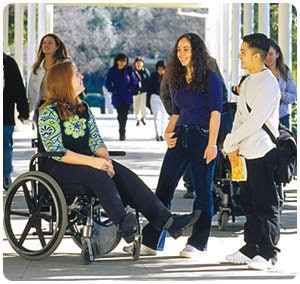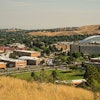 Thanks to an ADA provision that has recently taken effect, campuses are becoming more accessible to students with disabilities.
Thanks to an ADA provision that has recently taken effect, campuses are becoming more accessible to students with disabilities.Bryce Gitzen travels through the aboveground, enclosed, heated passageway, nicknamed “The Spine,” to get to the bookstore, sports center, library and other buildings on the University of Alaska, Anchorage (UAA), campus. The structure has elevators, with Braille floor indicators, wheelchair-accessible door openers, ramps and Wi-Fi service.
Gitzen, who was born with the eye disorders bilateral aniridia and glaucoma, is one of the 750-plus students with disabilities in the population of more than 21,000 students on campus. He said The Spine helps him “minimize contact with traffic and the Alaskan weather.”
Despite Gitzen’s severe visual impairment, “it is relatively easy for me to navigate the campus,” said the 21-year-old, who works as a legal assistant/tech guru at a local law office and as a UAA Disability Support Services tech assistant.
“Prior to attending the first session of a class, I prefer to locate the specific classroom and add it to my mental map,” he added.
Providing The Spine is one way the Anchorage school complies with the Americans with Disabilities Act of 1990. Colleges and universities, like other facilities and public accommodations, have been required to adhere to the ADA for the past 23 years. The United States Department of Justice first released regulations in 1991 to protect the rights of individuals with disabilities. The ADA regulations covered a range of issues from having sign-language interpreters to software that changes type to Braille.
The rules include the ADA Standards for Accessible Design that apply to structural, physical changes such as lowering signs and installing wheelchair-accessible door openers. Both the ADA regulations and standards for design came out in 1991 and were refined in 2010 with more specific details on compliance. They each address state and local government services (title II), and apply to public accommodations and commercial facilities (title III). On March 15, 2012, the Justice Department announced that the 2010 design standards would go into effect immediately.
Addressing New Issues
One reason the 1991 regulations and standards were revised was to add precise features that eliminate confusion and ensure consistency for everybody trying to comply. For example, many of the modifications apply to restrooms. These revisions include specifying the highest and lowest points a person has to extend his or her arms to use fixtures and accessories, as well as increasing the clear floor space required in a toilet stall to allow someone in a wheelchair to maneuver.
In addition, the earliest standards were based on adult dimensions and did not consider requirements for children and people of short stature at places such as drinking fountains, restrooms and sinks. The most recent standards lower the “reach range” requirements for mechanisms including light switches and thermostats from 54 inches in the 1991 standards to 48 inches. They take into account people of shorter height, along with those with limited upper-body strength and diminished use of the arms or fingers.
The new regulations also address technological advances made since 1991.
“There’s more discussion of things such as captioning on public-address systems, assembly areas, all the provisions for video-relay services that weren’t even around in 1991,” said Francine Wai, executive director for the Disability and Communication Access Board (DCAB), Department of Health, State of Hawaii. “And they’re all mentioned and incorporated into the new rules and new standards. Things are included that we would not have thought about or talked about because they weren’t part of our everyday life.”
‘Safe Harbor’ Provisions
Since 1991, colleges have been making changes to comply with the ADA standards, but if a building was constructed or barriers were removed in compliance with the original standards, no more changes have to be made to comply with the latest standards. That is except for features that weren’t already covered by the 1991 standards. For example, regulations for swimming-pool entry and exit were introduced for the first time in the 2010 standards, so pool facilities must comply.
This provision is referred to as the “safe harbor,” said Irene Bowen, president of ADA One LLC., who served as deputy chief of the Disability Rights Section at the U.S. Department of Justice and as deputy general counsel of the U.S. Access Board.
An example of safe harbor is the earlier standard that required one van-accessible space for every eight accessible spaces. The new standards require one van-accessible space for every six accessible spaces. If a facility is in compliance with the 1991 standards, then it does not have to add spaces.
Officials should have known which structures would need to be modified before the new standards went into effect last year, those familiar with the standards say.
“Many of these changes are changes that people have known about if they were in the design field and they were involved with disability,” Wai said.
Colin Donahue, associate vice president facilities development and operations at California State University, Northridge (CSUN), agreed. “In our industry, there is a heightened awareness of accessibility issues,” he said. “Each year, we make ADA upgrades to the campus through our capital projects and deferred maintenance projects.”
Some recent projects were the installation of ramps, repairs to sidewalks and parking lots, installation of Braille signage, auditorium-assisted listening devices, and upgrades to counters and restrooms.
“It’s like a little city,” said Donahue of the 365-acre campus. “We’re constantly repairing things.”
All construction plans for the campus, which has an average of 1,200 students with disabilities per semester, adhere to ADA standards and the California Building Code and are subject to approval by the California Division of the State Architect (DSA).
The division received 183 University of California projects and 180 California State University system projects for the period of Sept. 15, 2010, to Jan. 8, 2013, said Michael Liang, assistant deputy director, Office of Public Affairs, California Department of General Services. “For this same period, community colleges submitted 396 projects,” he said.
The Cost of Compliance
The architectural plans that schools send to the division do not break out the ADA compliance cost of projects that also include structural and architectural factors, said Dennis J. Corelis, deputy state architect, California Division of the State Architect.
“It’s hard to make generalizations,” he said. “The cost [of compliance] depends on specific campuses and the age of the buildings.”
Donahue agrees that it’s difficult to calculate just the cost of the ADA portion of construction at the Northridge campus.
“However, I would estimate that we complete at least $250,000 annually in ADA upgrades,” Donahue said.
The University of Alaska, Anchorage, has been renovating its buildings, as well.
“Back in 1990, the university was very small, and it was mostly a community college campus,” said Jon C. Deisher, director of Disability Support Services at UAA. At the time, Deisher worked on the Architectural Barrier Removal Committee that made recommendations to have older buildings retrofitted and new buildings constructed designed to be ADA compliant.
“Some of the buildings we had were so concrete and steel oriented that modifying them would’ve been an undue hardship to change,” Deisher said.
However, the school could modify elevators. So it made some of the elevator doors wider and got larger elevators for easier maneuvering with wheelchairs.
Other tasks this UAA committee approved were lowering water fountains and setting aside at least one urinal per restroom for wheelchair users and making some restroom stalls wheelchair accessible, along with adding rails.
“UAA practices the philosophy of ‘universal design’: the university’s accessibility compliance for persons with disabilities makes the entire campus accessible and more user friendly to everyone,” Deisher said.
Retrofitting Buildings
At Miami University in Oxford, Ohio, it’s also an ongoing process retrofitting older buildings to meet ADA standards. Miami University was founded in 1809, and many of the buildings, built in the late 1800s or early 1900s, are being stripped down to the studs. The buildings will have either “even entry” — level surfaces at entries with no obstacles — or ramps at entrances, said Andy Zeisler, director of Miami University’s Office of Disability Resources. Miami used to modify students’ rooms adding handrails and adjusting closet poles as requested.
“Now, we’re building these accessible options into suites,” Zeisler said.
In his 25 years in this position, Zeisler said he has seen the installation of more curb cuts, ramps, audible crossing signals, power doors, visible alarms and lowered filtered-water bottle filling stations.
With 15 residence halls already meeting standards, “Miami is currently in the process of building six new residence halls and renovating another,” said Ritter Hoy, media relations representative at Miami University. Three halls will open in the fall of 2013; the other three will open in the fall of 2014. All of these halls are being built to ADA standards.
In 2011, Miami University had 724 students with disabilities across three campuses from a total population of more than 17,000 students and 100 staff and faculty members with disabilities, Hoy said.
The university made a name for itself by being ranked the No. 1 public university in the state of Ohio for 2012 by Forbes magazine and being featured on MTV’s True Life when Derek Zike, now a junior, was profiled twice for adjusting to life in a wheelchair after being paralyzed during a hockey game at age 17.
Putting Technology to Use
In addition to the standards to remove physical barriers, ADA rules stipulate that educational technology be used to prevent discrimination of persons with disabilities. Electronic equipment already in use is influencing the future of learning.
“For higher education, the biggest change in ADA rules will be the way people switch to using new devices for learning,” said Wai, of DCAB in Hawaii. “Instructions and classes online having to be accessible, which will allow more people to have access, but it also means that those individuals who may rely on traditional means of using books will not necessarily have the easiest level of access.”
Using online classes benefits anyone who has difficulty coming to class and learning the traditional way with books and listening to an instructor. That includes people with physical, visual, hearing and learning disabilities such as attention deficit disorder and dyslexia.
Many educational technological advances benefit everyone on campus, not just students with disabilities. For example, studying online might be especially helpful to someone with less mobility, but it can benefit all students, because they can do work at more convenient times, at alternative locations and often with additional study time than during scheduled classes.
Miami University already is using advanced technology with tap-and-go keycards. Everyone on campus has an identification card with a microchip that unlocks his or her residence hall room or office, Hoy said. If cards are lost or locked in the room, the rightful user can send a text message on a smartphone and gain entry. This new Wi-Fi system helps students like Zike, the student who was profiled on MTV, because his door unlocks when his wheelchair is near his room’s receiving pad.
Miami also uses e-text services to convert print to alternative-access formats. Volunteers cut the binding of books, scan pages and put them in formats that can be downloaded and used for audio-screen readers, and Braille for visually impaired students or condensed to an outline form for students with learning disabilities, including ADD and dyslexia, Zeisler said.
The University of Alaska, Anchorage, offers several technology-based services that help disabled students, including computers with adaptive-software books, digital (PDF) versions of textbooks, closed caption TV/video magnifiers, and smartpens to make an audio and visual recording of lecture notes.
While campus communities are making progress with technological and structural changes, sometimes attitudes need adjusting.
Last semester, when one elevator on the Anchorage campus needed repair, some classes had to be moved so that students who couldn’t walk upstairs would be on the first floor. Only the displaced instructors initially complained, Deisher said.
“Our thoughts here are that the biggest barrier to disability is the attitude,” Deisher said. “We have to have an attitude that removes barriers not because a person is disabled but because it’s just a sensible thing to do.”
Zeisler at Miami University agrees that the right attitude about disability makes a difference.
“What really impresses me over the years is that disability is included in the discussion about culture and diversity,” Zeisler said. “We have a seat at that table.”
— Marsha Gilbert is a freelance journalist whose work has appeared in several national magazines, newspapers and websites. She is also an award-winning fiction writer.















